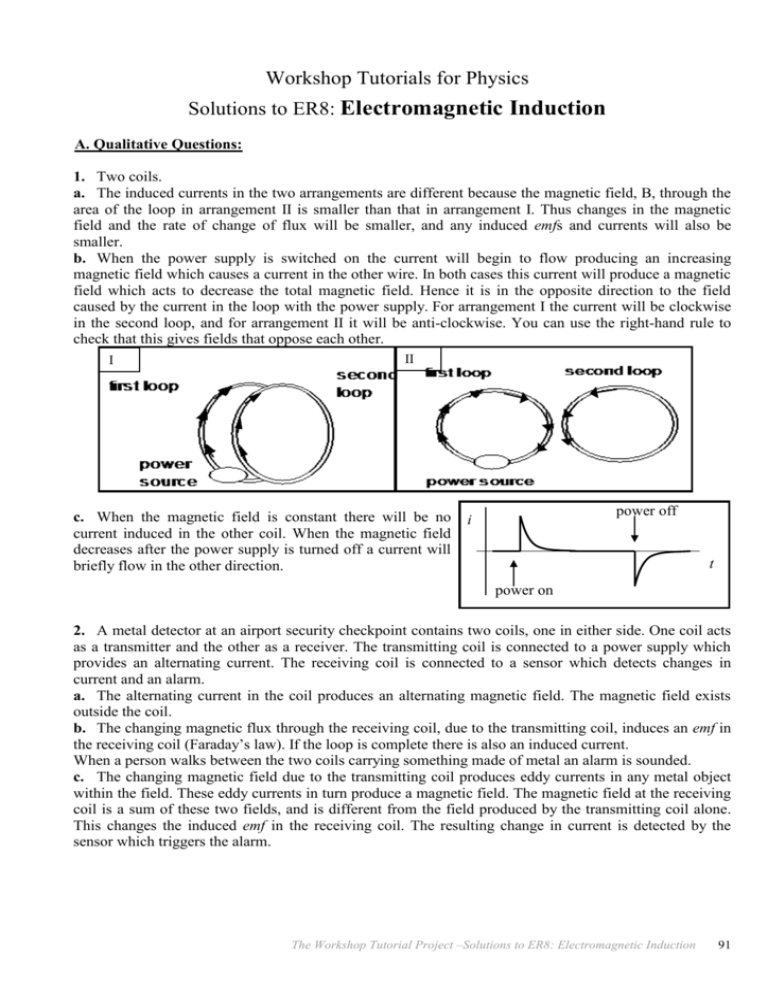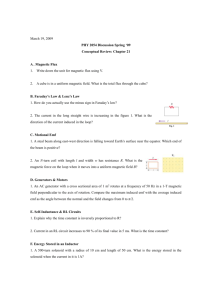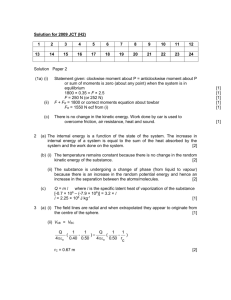Word
advertisement

Workshop Tutorials for Physics Solutions to ER8: Electromagnetic Induction A. Qualitative Questions: 1. Two coils. a. The induced currents in the two arrangements are different because the magnetic field, B, through the area of the loop in arrangement II is smaller than that in arrangement I. Thus changes in the magnetic field and the rate of change of flux will be smaller, and any induced emfs and currents will also be smaller. b. When the power supply is switched on the current will begin to flow producing an increasing magnetic field which causes a current in the other wire. In both cases this current will produce a magnetic field which acts to decrease the total magnetic field. Hence it is in the opposite direction to the field caused by the current in the loop with the power supply. For arrangement I the current will be clockwise in the second loop, and for arrangement II it will be anti-clockwise. You can use the right-hand rule to check that this gives fields that oppose each other. I II c. When the magnetic field is constant there will be no current induced in the other coil. When the magnetic field decreases after the power supply is turned off a current will briefly flow in the other direction. power off i t power on 2. A metal detector at an airport security checkpoint contains two coils, one in either side. One coil acts as a transmitter and the other as a receiver. The transmitting coil is connected to a power supply which provides an alternating current. The receiving coil is connected to a sensor which detects changes in current and an alarm. a. The alternating current in the coil produces an alternating magnetic field. The magnetic field exists outside the coil. b. The changing magnetic flux through the receiving coil, due to the transmitting coil, induces an emf in the receiving coil (Faraday’s law). If the loop is complete there is also an induced current. When a person walks between the two coils carrying something made of metal an alarm is sounded. c. The changing magnetic field due to the transmitting coil produces eddy currents in any metal object within the field. These eddy currents in turn produce a magnetic field. The magnetic field at the receiving coil is a sum of these two fields, and is different from the field produced by the transmitting coil alone. This changes the induced emf in the receiving coil. The resulting change in current is detected by the sensor which triggers the alarm. The Workshop Tutorial Project –Solutions to ER8: Electromagnetic Induction 91 B. Activity Questions: 1. Electromagnetic Induction – two coils of wire and a magnet The direction of the current depends on the motion of the magnet relative to the loop and changes when the magnet is reversed. The magnitude of the current depends on the speed of the motion, number of turns of wire and the angle between the loop and the magnet. It doesn’t matter whether the coil or the magnet is moved, only the relative motion of the two is important (it was this observation that led Einstein to his theory of relativity). A current-carrying coil of wire has a magnetic field so there will be an induced current in a closed loop of wire which is moving relative to a current-carrying coil. 2. Torque on a current-carrying coil in a magnetic field S N S N both forces non-zero and perpendicular to plane of coil. all forces in plane of coil. If it is held stationary prior to release, the loop on the left is more likely to start turning on its own. 3. Magnetic braking and damping – magnets in pipes The movement of the magnet creates currents in the copper pipe, which produce magnetic fields, which act to oppose the motion which causes them, slowing the fall of the magnet. The plastic pipe is an insulator, no current is created and hence the magnet is not braked. In the pipe with the slit there are still currents produced in vertical loops, but not around the pipe as the slit prevents this. So the fall is slowed, but not as much as in the complete pipe. 4. Jumping Rings An AC coil with a long iron core produces an alternating magnetic flux, mostly in the region in and near the core. An emf is induced in a small conducting ring when it is slipped over the core and the power is turned on to the coil. If the ring is complete, a current is also induced and the resulting magnetic force is sufficient to launch the ring several feet into the air. A split ring or a non-conductive ring will not jump because no current is induced. C. Quantitative Questions: 1. MRI scans and induced currents. a. The changing magnetic field will induce a current. Metal jewelry or zips etc have low resistance so large currents could be induced in them. b. According to Faraday’s law the induced emf = -dB/dt, which is the rate of change of magnetic flux. B = B.dA = B.A for a uniform field. So now we have emf = -dB/dt = d(B.A)/dt = B.A/t for a steadily changing field, or for the average value. We want the maximum value of the emf to be 0.01 V, and we are finding t: t = B.A/emf = 1.5 T 0.04 m2 / 0.01 V = 6 s. It must take at least 6 s for the machine to reduce the field to zero. 2. The component B perpendicular to the area swept out by the blades is Bperp = Bsin 60o = 43 mT. 3. The blades sweep out an area of r2 = (5.0 m)2 = 25 m2 per revolution. They revolve 200 times per minute, which is 200/60 times per second, so they sweep out an area of 200/60 25 m2 per second. Hence the induced emf = B × d(A)/dt = 200/60 25 m2 s-1 43 mT = 11 V. 92 The Workshop Tutorial Project –Solutions to ER8: Electromagnetic Induction






